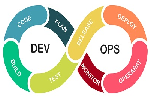DevOps Principles
DevOps defines an active relationship between operations and development. It is a process where the development team and operational engineers work together from beginning to end.
Workflows show a visual overview of orders in which inputs are provided. It expresses you about activities and productions are produced based on working processes. It has the ability to arrange and search for jobs that are frequently requested by users. It gives you the ability to mirror the ideal processes in configuration jobs.
- Parallel job execution
- Sequential Job execution
- Brach-level filtering
DevOps Workflow:

The DevOps seminar will help you to learn DevOps from scracth to deep knowledge of various DevOps tools such as fallowing List.
Kubernetes.PRINCIPLE 1
Customer-Centric Action
It is imperative nowadays to have short feedback loops with real customers and end-users, and that all activity in building IT products and services centers around these clients. To be able to meet these customers’ requirements, DevOps organizations require the guts to act as lean startups that innovate continuously, pivot when an individual strategy is not (or no longer) working, and constantly invests in products and services that will receive a maximum level of customer delight.
PRINCIPLE 2
Create with the End in Mind
Organizations need to let go of waterfall and process-oriented models where each unit or individual works only for a particular role/function, without overseeing the complete picture. They need to act as product companies that explicitly focus on building working products sold to real customers, and all employees need to share the engineering mindset that is required actually to envision and realize those products.
PRINCIPLE 3
End-To-End Responsibility
Where traditional organizations develop IT solutions and then hand them over to Operations to deploy and maintain these solutions, in a DevOps environment teams are vertically organized such that they are fully accountable from concept to grave. IT products or services created and delivered by these teams remain under the responsibility of these stable groups. These teams also provide performance support, until they become end-of-life, which greatly enhances the level of responsibility felt and the quality of the products engineered.
PRINCIPLE 4
Cross-Functional Autonomous Teams
In product organizations with vertical, fully responsible teams, these teams need to be entirely independent throughout the whole lifecycle. That requires a balanced set of skills and also highlights the need for team members with T-shaped all-round profiles instead of old-school IT specialists who are only knowledgeable or skilled in for example testing, requirements analysis or coding. These teams become a hotbed of personal development and growth.
PRINCIPLE 5
Continuous Improvement
End-to-end responsibility also means that organizations need to adapt continuously in the light of changing circumstances (e.g. customer needs, changes in legislation, new technology becomes available). In a DevOps culture, a strong focus is put on continuous improvement to minimize waste, optimize for speed, costs, and ease of delivery, and to continuously improve the products/services offered. Experimentation is therefore an important activity to embed and develop a way of learning from failures is essential. A good rule to live by in that respect is if it hurts, do it more often.
PRINCIPLE 6
Automate Everything You Can
To adopt a continuous improvement culture with high cycle rates and to create an IT organization that receives instant feedback from end users or customers, many organizations have quite some waste to eliminate. Fortunately, in the past years, enormous gains in IT development and operations can be made in that respect. Think of automation of not only the software development process (continuous delivery, including continuous integration and continuous deployment) but also of the whole infrastructure landscape by building next-gen container-based cloud platforms that allow infrastructure to be versioned and treated as code as well. Automation is synonymous with the drive to renew the way in which the team delivers its services.
Learn Latest Technologies

DevOps

AWS

Python

Azure

G Cloud

Linux

Web Tech

Data Bases

Testing

Git

Ansible

Chef

Kubernetes

HTML

CSS

